
The 7 Craziest Comics of Bob Haney: From JFK Shapeshifters to Satanic Nazis

This year, the Eisners are honoring the legendary Bob Haney with the 2011 Bill Finger Memorial Award for Excellence in Comics Writing, and if you ask me, that's long overdue. In a career that spanned five decades, Haney's contributions to the DC Universe included co-creating the Teen Titans, Metamorpho and Eclipso and a long run as the writer of The Brave and the Bold, working with artists like Neal Adams and the incredible Jim Aparo.
And he also wrote some of the craziest comic books I have ever read, like the time Batman sold his soul to the devil, the the time they retconned the JFK assassination with shapeshifters, and the time the Atom resurrected a man from the dead by doing gymnastics on his cerebellum.Haney didn't just embrace the wild, anything-goes attitude of the Bronze Age, he strapped a jetpack on it and rocketed it to a headquarters at the center of the sun. He set the gold standard for an entire era of DC comics, writing stories in which no premise was too insane to make a grand adventure and no character was off-limits for a team-up with Batman. So with the award being officially handed down next month, ComicsAlliance has decided to show you just why he's so great with a look at Bob Haney's Craziest Stories!


Haney's most prominent role at DC was unquestionably his tenure as the writer of Brave and the Bold, during which he scripted dozens of Batman team-up stories that were frequently among the Dark Knight's most bizarre adventures. Case in point, Brave and the Bold #108, with art by Jim Aparo, in which Batman teamed up with Sgt. Rock and sold his soul to the Devil.
The fact that Batman was hanging out with Sgt. Rock in 1973 was itself a point of contention for a lot of readers, since Rock's creator (and fellow crazy comic writer) Robert Kanigher had previously gone on record as saying that Rock was killed on the last day of World War II. Of course, Kanigher had previously written a story where Rock was seen after the war, which is why Haney decided to include him in BATB in the first place, but... well, suffice to say that it's complicated. Just trust me on this one: All things are possible on Earth-Haney.
The more important aspect of the story, though, comes when Batman, attempting to rescue a kidnapped child with a rare blood disease, is shot and dumped unceremoniously down a well to drown.
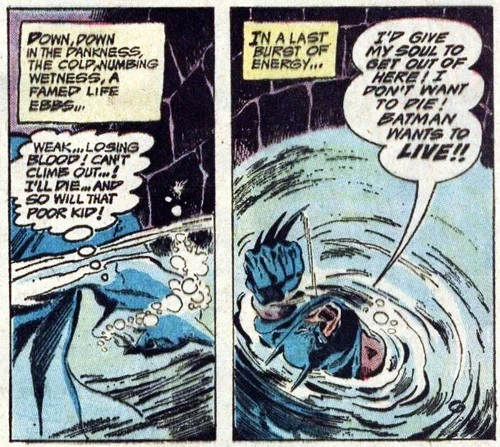
That's right: Batman is willing to sell his soul in order to get a second chance at punching out a criminal. Oh, and also saving the kid, but let's be honest: It's mostly the punching.
This being comics, just saying that out loud is enough to summon Satan from the fiery depths of hell, and sure enough, a mysterious man drops the rope and bucket down the well and hauls Batman out so that he can get a second chance at crook-bashing. But after returning to Gotham City, Batman runs into the same mysterious man, who tells him that at his command, Batman will start committing acts of pure evil, an ominous statement that seems to come true when an ex-con who was going straight throws himself into the path of a speeding truck rather than talk to Batman.
At this point, Batman's getting understandably worried about the taint of Lucifer upon his soul, but fortunately, Sgt. Rock shows up and lets him know that everything's all right. There's nothing to worry about -- It's not really the devil that's been harrassing Batman all this time.
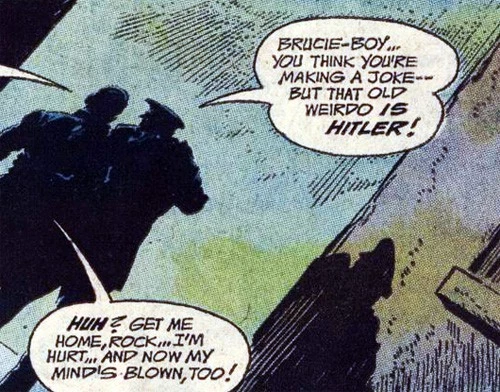
IT'S ACTUALLY ADOLF HITLER.
Even better, it's really actually both. Maybe. After Batman karate-chops some Satanic Nazis on the roof of a train that ends up at Hitler's secret underground bunker and Sgt. Rock makes a solid but unfortunately failed effort at capping der Führer, Batman talks about how the spirit of evil is always around, and we get a shot of the mysterious guy limping away, casting the shadow of the Devil on the ground in front of him.
Students, if you are ever asked to write a paper about World War II, please include all of this information. You will most likely fail, but it's worth it.

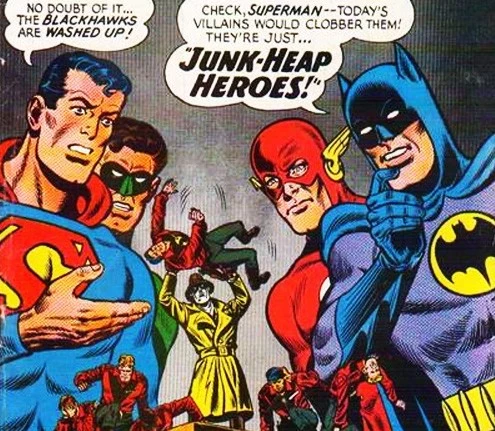
Created by Will Eisner, Chuck Cuidra and Bob Powell in 1941, the Blackhawks were a team of independent fighter aces who fought the Nazis and then, after the war, turned their attention to... well, to still fighting Nazis most of the time, but really, can you blame them? Anyway, by the '60s, Blackhawk had largely become a comic about a bunch of fighter pilots who would often go several issues without actually flying a plane. Clearly, the formula needed some changing.
Enter Bob Haney and artist Dick Dillin in 1967, who set out to revitalize the team by leading readers into "The NEW Blackhawk Era," which started with Superman, Batman and the rest of the Justice League basically calling the team to a meeting so that they could tell them how bad they sucked. Batman specifically called them out on "antiques" who "just don't swing," with the message being that their out-of-date tactics just couldn't cut it in the grim and gritty world of DC's Silver Age. Seriously.
The solution? Recasting the Blackhawks as The Worst Super-Heroes Ever.

Under the orders of Blackhawk the rest of the team took new codenames and identities, and they were rough. Sure, "The Weapons Master" has a nice ring to it, and "The Golden Centurion" at least had a set of impenetrable Iron Man armor that they got by throwing its previous owner into a volcano and burning him alive (no joke!), but it's a pretty steep, sharp decline to get from there to "The Listener" and his terrible ear-covered pajamas.
What's really telling, though, is that Blackhawk himself decided to just go ahead and stick with "Blackhawk," with his new gimmick being that he flew around in an airplane. One imagines that this decision might've been made after seeing what the rest of the team was up to.
The Era -- such as it was -- lasted less than a year, and astonishingly, these guys haven't been seen since. Not even Dr. Hands and his rented tuxedo! What gives?

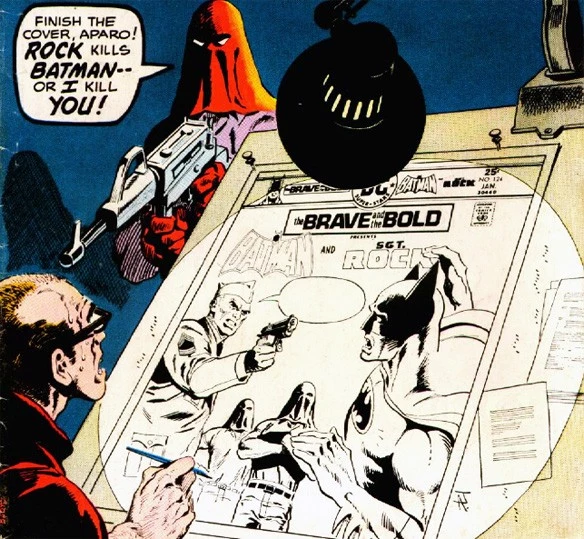
Haney wrote a lot of unlikely team-ups in the pages of Brave and the Bold, but never moreso than in BATB #124. The story was ostensibly another Batman/Sgt. Rock tale (Sgt. Rock apparently being the character who brought out the madness in Haney's work), but it's actually a team-up between Rock, Batman, Bob Haney and Jim Aparo, with a cameo by editor Murray Boltinoff.
And it all gets started when The Thousand, the gang of terrorists menacing Our Heroes in the story, show up at Jim Aparo's house to force him to draw Batman and Sgt. Rock dying in the comic they are all in right now.
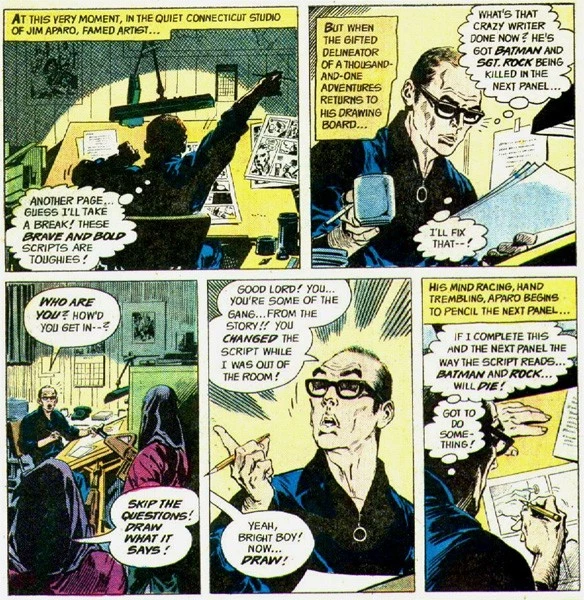
Admittedly, this is a pretty great plan. I mean, the only real way to kill someone in comics -- albeit usually temporarily -- is to get the creators to do it. But while Aparo's apeerless apenciling certainly seems to have definitive power over what Rock and Batman are doing, it's not like the bad guys came to the "real world" in order to make this happen. Everyone seems to exist within the story itself.
The only conclusion?
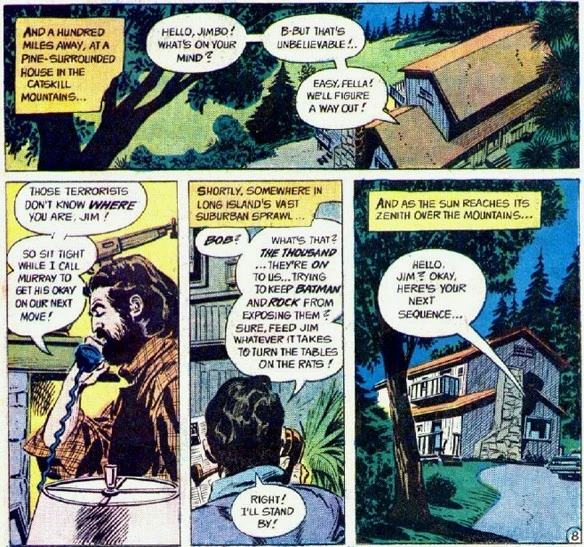
Jim Aparo and Bob Haney are gods. Could there be any other reason for that bearded majesty?
Unsurprisingly, the story ends with Haney and Aparo getting away and secretly assisting the Batman in bringing down the crooks, but honestly, why isn't this done more often? Sure, comics are always putting fictional universes in danger, but "Batman wins or you, the writer of Batman, will face the consequences?" That is how you motivate someone to tell a great story.

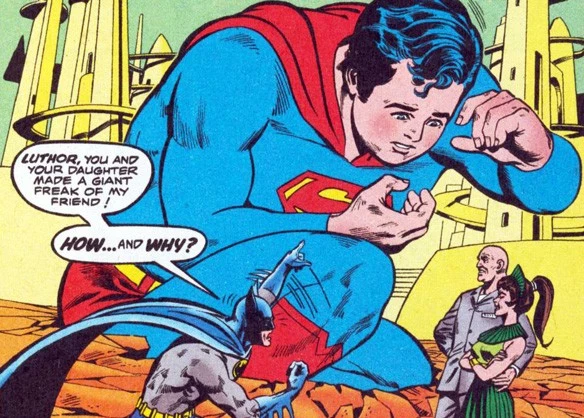
Of all of Bob Haney's creations in the DC Universe -- including, if you want to get technical, himself and Jim Aparo -- the most successful were unquestionably the Teen Titans, so it's understandable that he'd eventually go back to the well of teenage super-heroes eventually.
And he did just that in the pages of World's Finest #215, when he and Dick Dillin created The Super-Sons! Set in an imaginary (but aren't they all?™) future, the Super-Sons were the children of Superman and Batman. Except that really, they were just those characters as teenagers hanging out with each other. There was no real change involved at all, to the point where they wear the same costumes and their names are even "Bruce Wayne Jr." and "Clark Kent Jr."

The only discernible difference is that they were always being hassled by their fathers and perpetually faceless, unidentified mothers.
Either way, their adventures mostly consisted of riding around America on a motorcycle (occasionally in costume) and swapping the hip, "with it" bits of slang that make up Haney's trademark dialogue. They took their dads to a new-age camp to bond over primal scream therapy (seriously) and once even faced the horror of A Town Run By Women!!
Also, they had pillowfights.
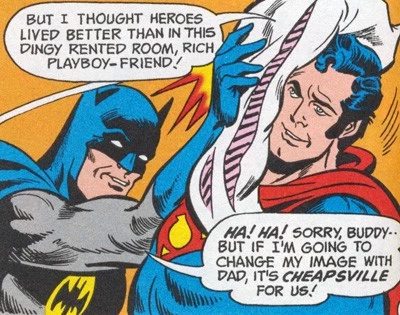
And for bonus, non-Haney weirdness, the saga came to an end in a story by Denny O'Neil and Rich Buckler where the Super-Sons were revealed to be a computer simulation that Superman and Batman cooked up for their own enjoyment, only to have them come to life and start emitting dangerous radiation, which led to Superman and Batman ordering them to destroy themselves in a disintegration pit. Kind of a dick move, World's Finest.

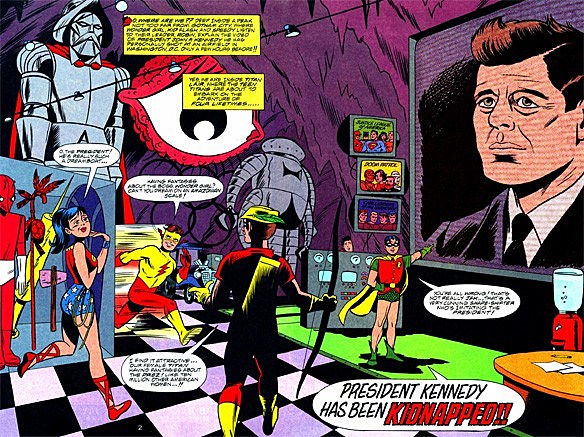
Speaking of the Teen Titans, Haney's final story before his death in 2004 was a return to the franchise he'd co-founded with The Teen Titans Lost Annual, and it is amazing. For one thing, it features the art of Jay Stephens and Mike Allred with a cover by original Titans artist Nick Cardy. And then there's the story, set in the swingin' '60s -- an era that provided the backdrop for his original stories -- and focusing on an alien plot to kidnap John F. Kennedy and replace him with a shape-shifting alien.
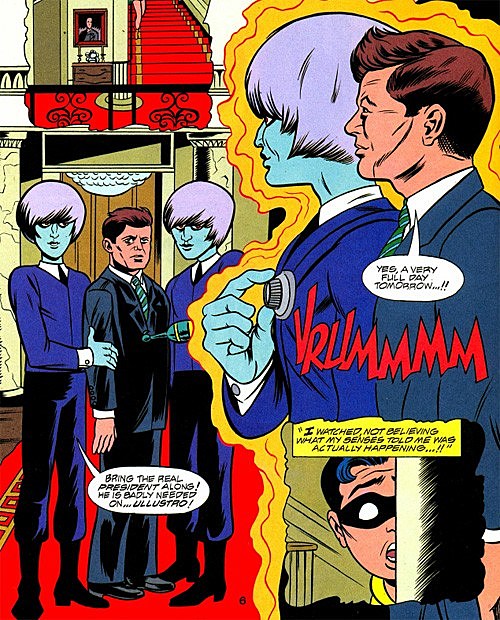
The aliens who do the kidnapping -- who look suspiciously like extraterrestrial mods -- took Kennedy because they needed his help to resolve a war they were engaged in with another gang of aliens, who looked suspiciously like outer-space rockers:
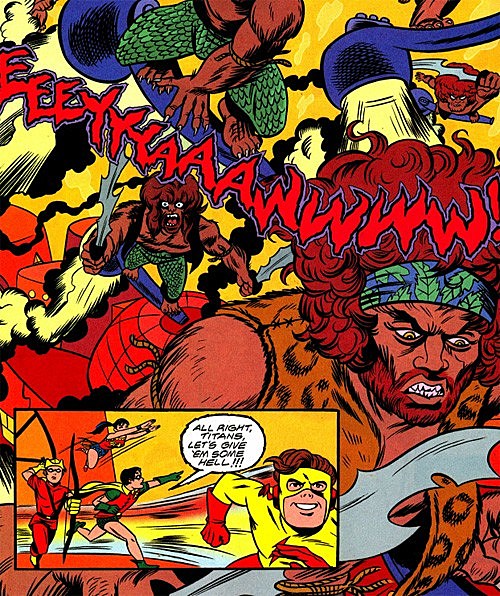
To that end, the aliens brainwashed Kennedy to make him forget he was ever president, leaving one of their own in his place. Unfortunately, by the time the Titans had rescued him, the ersatz JFK had been shot in Dallas, and rather than upset a cynical public with his return, the real Kennedy opted to stay in space and form a gang of space-faring ray-gun soldiers to deal with cosmic threats.
If this is not considered a core building block of the new DC Universe, then brother, I don't even know.

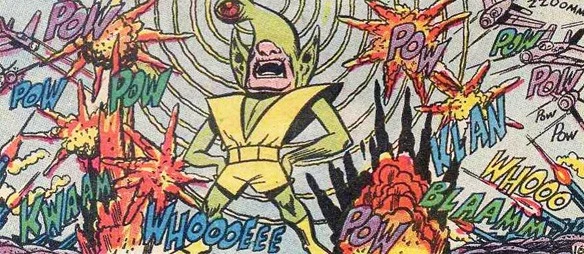
My favorite of Haney's creations is unquestionably Metamorpho, the Element Man, the swingin' super-hero of 1,001 fab chemical changes that he and Ramona Fradon introduced in 1965. The stories are hilarious, action-packed and read like they're ten years ahead of everything else DC was putting out at the time, and the greatest of all Metamorpho sagas was a three-part story in which the E-Man battled The Thunderer. And considering that there was a two-parter where he had to play football with an atomic bomb against a team of evil versions of the Metal Men, that's saying something.
Given that Haney referred to Metamorpho in captions as being "The World's Second-Greatest Comics Magazine (But He Tries Harder)," it's no surprise that he was keenly aware of what Stan Lee and Jack Kirby were doing down the block at Marvel, and the three-issue Thunderer story is a blatant, hilarious parody of the previous year's three-issue Galactus saga in Fantastic Four. There's even a herald -- Neutrog the Forerunner! -- who shows up just like the Silver Surfer to announce his master's arrival.
The difference? Unlike the cosmically huge Galactus, the Thunderer was two feet tall.
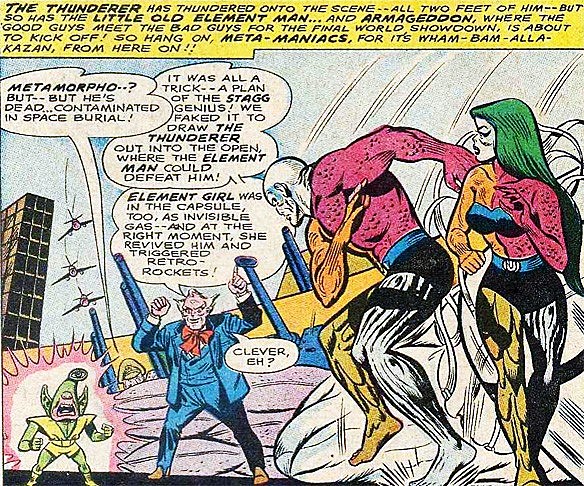
Despite his tininess, the Thunderer was no less powerful than his Kirby-helmeted counterpart, quickly dominating the entire world and withstanding any attack. But unlike the Fantastic Four, who had to rely on the intervention of Uatu the Watcher and the vague threat of the Ultimate Nullifier, Metamorpho was able to turn to 13 year-old Billy Barton and quite possibly the greatest weapon in the history of comic books:

A guitar that shoots laser beams!
Bob Haney, everybody: The dude who looked at the Galactus saga and went "pft, is that all you got?"

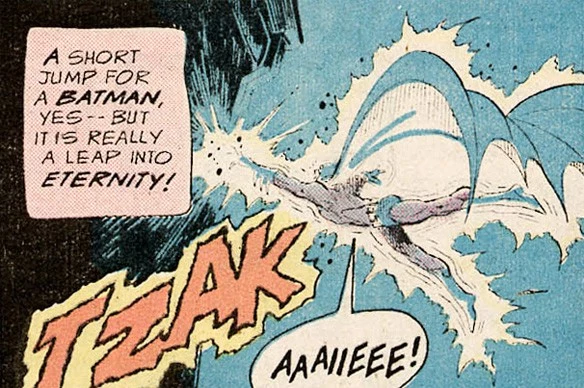
Much as I love Metamorpho, though, the award for Haney's craziest story has got to go to Brave and the Bold #115. For one thing, it's a story that opens with Batman dying, and really, that's a hell of a way to kick off a comic book.
Of course, as it turns out, Batman's only mostly dead. Specifically, his brain functions have ceased, but his "iron constitution" (we're talking at least 18 here) is keeping his body alive for a last few hours. And to make matters worse, Batman was working a kidnapping case, and only he knows where the goons are holed up with a young lady they abducted!
Fortunately for Batman, he lives in the DC Universe, and even more fortunately, the Atom is in town giving a guest lecture at Gotham University. So naturally, with all of this information, the Atom does the sensible thing:

He climbs into Batman's brain and stomps around on it. Also, he has a little TV with him so that he can see what Batman's doing. You know, as one does.
This, thanks to Science!, stimulates Batman's brain and allows his instincts and reflexes to take over. And this being Batman, his reflexes -- which I want to specify are his involuntary reactions to the world around him -- are to go find crooks and beat the living hell out of them.

It's just what comes naturally to him. It's also worth noting that even within the story itself, the Atom refers to what he's doing as "the craziest thing a man has ever done," and I've got to say I agree.
Plus, it provides foolproof logic for why Identity Crisis sucks: In the DC Universe, Shrinking down and stomping on someone's brain doesn't kill them, it turns them into a super-awesome unstoppable crime-fighter and then magically brings them back to life.
Thank you, Bob Haney.
More From ComicsAlliance








![MVP: Who Is The Greatest Teen Titans Member? [Poll]](http://townsquare.media/site/622/files/2017/03/Teen-Titans-Vote.png?w=980&q=75)
